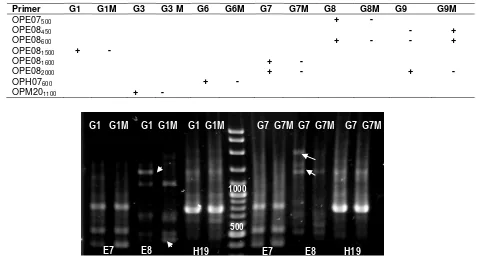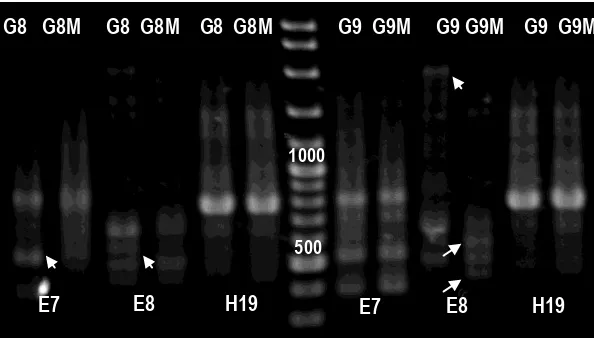http://dx.doi.org/10.17503/Agrivita-2012-34-2-p161-165
IDENTIFICATION OF M4 GAMMA IRRADIATED MAIZE MUTANT
BASED ON RAPD MARKERS
Rustikawati1*), Eko Suprijono1), Atra Romeida1), Catur Herison1) and Surjono H. Sutjahjo2) 1)
Faculty of Agricuturel University of Bengkulu Jl. Raya Kandang Limun Kota Bengkulu Bangkahulu Bengkulu 2)
Departement of Agronomy and Horticulture, Faculty of Agriculture
Bogor Agricultutal University Jl. Raya Darmaga Kampus Darmaga Bogor 16680 West Java, Indonesia *) Corresponding author Phone: +62-736-21170 E-mail: [email protected]
Received: January 6, 2012/ Accepted: April 23, 2012
ABSTRACT
Gamma irradiation to induce mutation in plant has been used intensively since several decades ago. On maize, 275 Gy gamma irradiation has been known to increase genetic variability indicated by its morphological variation. Identification of genetic changes by molecular technique is important to detect mutation on DNA level of the plants. The objective of this research was to identify RAPD marker polymorphism on gamma irradiation mutants compared to their parents. The initial step of the research was to select random primers which could positively amplify the maize DNA. The result showed that among 60 random primers there were 15 primers that positively amplified the maize DNA. Amplification of both mutants and their parents by those 15 selected primers indicated that only 5 primers had polymorphism between mutants and their parents. Polymorphisms on mutant G1, G3 and G6 were detected at one locus, while on mutant G7, G8 and G9 were at two loci.
Keyword: maize, mutation, RAPD
INTRODUCTION
In Indonesia, the development of cultivars from induced mutation has been carried out in cooperation with PATIR BATAN. In 1972 rice varieties 'Atomita' has been released resulting from gamma irradiation (BATAN, 1996). Until recently, BATAN has produced thirteen lowland rice varieties, one upland rice variety, four soybean varieties, one mungbean variety, and one cotton variety (Sisworo et al., 2008).
Physically induced mutations with gamma ray irradiation can be done to improve the genetic diversity of a base population (Micke and Donini, 1993). The successful attempt of irradiation to increase genetic variation of a population is largely determined by genotype radio sensitivity. Level of sensitivity of plant and crop highly varied between plants or genotypes (Banerji and Datta, 1992). Radio sensitivity can be measured based on LD50 which is the level of irradiation bringing about the death of 50% of the population. Some studies suggested that the optimum dose to produce mutant most commonly occurs in approximately LD50 (Ibrahim, 1999). In addition to the LD50, radio sensitivity is also observed from the growth inhibition or lethality, somatic mutations, chromosome fragments, and the number and size of chromosomes (Datta, 2001). In maize, a dose of 275 Gy irradiation increased the diversity of leaf number, length and width from 30% to 80%, while plant height increased by 250% to 1300% (Rustikawati et al., 2008b).
Identification of induced mutation plants can be aided by morphology, enzymatic or molecular characterization. Morphological identification is the most inexpensive and the easiest to do, but errors of non-inherited epigenetic traits are relatively more frequent. Enzymatic identification on gamma ray induced carnation mutation which produced five mutants. The peroxidase enzyme (PER), the esterase enzyme (EST) and the acid phosphatase enzyme (ACP) showed a different banding pattern among the five carnation genotypes tested (Aisyah, 2006). The last few years, molecular markers have been widely used as tool in basic genetics studies and their application. Various size of DNA fragments produced by amplification can be easily separated by electrophoresis technique
and the results can be observed as bands of DNA at various size (Griffin and Griffin, 1994). DNA marker is more accurate because it is not influenced by environment and plant growth stage. Among the DNA markers, RAPD is the easiest to do, therefore, in this identification of gamma irradiation induced maize mutant is carried out using RAPD molecular markers.
MATERIALS AND METHODS
The study was conducted from September 2009 to August 2010. Plant materials used were six genotypes of maize and six S4 mutants induced by gamma irradiation at a dose of 275 Gy. The induced mutants were then selfed for 4 generations. The six mutants were G1-12-18a-1 (G1M), G3-15-17-4 (G3M), G6-6-19-19a (G6M ), G7-15-9-3 (G7M), G8-4-8-6 (G8M), and G9-20-44-2 (G9M). DNA samples were isolated from leaves of 2-week-old plants. RAPD analysis was conducted at the Laboratory of Molecular and Cellular Department of Agronomy and Horticulture, Bogor Agricultural University.
DNA Extractions
DNA extractions were performed following a protocol based on DNA EXRACT KIT RED-AMP. DNA purification was done by the addition of the CIA and DNA precipitation using 95% alcohol. The quality and purity of DNA were determined by calculating the ratio of absorbance value of the prepared DNA at A260 to A280. The value of 1.8 – 20 indicated good quality DNA (Herison et al., 2003).
Primer Selection and Identification of RAPD Markers
A total number of 60 different primers from the Operon Tecknologies OPE, OPH and OPM, has been tested. Fifteen random selected primers were used for DNA amplification of maize mutant and the wild types. DNA band polymorphism of mutant and wild types was used to establish the occurrence of the mutant. Amplification was done with a DNA concentration of 10-25 ng. The PCR program included a pre-PCR (94oC, 5 products were visualized by ethidium bromide staining and UV transiluminator.
RESULTS AND DISCUSSION
RAPD Primer Selection
DNA template for primer selection was derived from line G1. There were 15 DNA primers out of the 60 random primers tested, which were suitable for maize. Sequences of each primer and the number of bands produced were listed in Table 1.
RAPD Marker Identification
PCR template for identification of polymorphism was selected from the DNA of G1, G3, G6, G7, G9 either from the parents or the gamma-ray irradiated mutants. Each DNA was amplified by 5 selected primers. Visualization of PCR electrophoreses were done simultaneously with marker of 1 kb ladder. Markers were needed for quantification of DNA bands based on the length of the fragment. Figure 1 and Figure 2 presented some of the result of DNA amplification. Polymorphism banding pattern between the mutant and parentals was indicated by arrows.
The results obtained from RAPD analysis with the OPE-08 primer for the inbred line G1 presented a band of 1500 bp, whereas the G1M showed no band. The different band pattern indicated that both DNAs were also different. DNA band size differences resulting from the
same primer was assumed that the diferences were from different loci. Based on the results of DNA amplification, all the gamma irradiation mutants were different in nucleotide sequences from their parents (Table 2).
Polymorphism on RAPD banding pattern was due to mutations in the DNA level of irradiated maize. Point mutations or changes in a DNA base was able to cause differences of the template, resulting in differences in RAPD banding pattern. Micke and Donini (1993) states that gamma irradiation could ionize atoms in the tissue by releasing electrons from the atoms. Ionization triggered molecule clustering along the ion orbits left due to irradiation. Such new grouping led to chemical changes bringing about to errors in organic bases pairing in DNA. Those resulted in gene mutations or the destruction or rearrangement of chromosomes.
Tabel 2. RAPD polymorphism band pattern of gamma irradiation mutants and their respective parents DNA
Primer G1 G1M G3 G3 M G6 G6M G7 G7M G8 G8M G9 G9M
OPE07500 + -
OPE08450 - +
OPE08600 + - - +
OPE081500 + -
OPE081600 + -
OPE082000 + - + -
OPH07600 + -
OPM201100 + -
Figure 1. Product amplification of maize mutants and their parents of G1 and G7 with 07, OPE-08 and OPH-19 primer
G1 G1M G1 G1M G1 G1M G7 G7M G7 G7M G7 G7M
E7
E8
H19
E7
E8
H19
1000
Figure 2. Product amplification of maize mutants and their parents of G8 and G9 with OPE 07,OPE-08 and OPH-19 primer
Consistency of RAPD bands as molecular markers of plants has been demonstrated by Herison, et al. (2010) in the banding pattern identification BC2 plants chili with recurrent elders. The same primer used for the identification of BC3 plants produce an identical banding pattern. RAPD markers have also been used for the analysis of gene linkage to CMV resistance in hot pepper (Rustikawati et al., 2008a).
CONCLUSIONS AND SUGGESTIONS
All gamma irradiation maize mutants produced polymorphism DNA banding pattern from their parents. Based on the generated RAPD banding pattern, polymorphism in the mutant G1, G3 and G6 occurred at one locus, while the G7, G8 and G9 occurred at two loci. Thus, the 275 Gy of gamma irradiation was consider successfully induced mutations in the DNA of maize.
REFERENCES
Aisyah, S.I. 2006. Mutasi induksi fisik dan pengujian stabilitas mutan yang diperbanyak secara vegetatif pada anyelir (Dianthus caryophyllus Lin.) Disertasi. Program Studi Agronomi Sekolah Pascasarjana IPB.
Badan Tenaga Atom Nasional. 1996. Radiasi
translation of W.Bjorn, Radiation in Everyday Language. 91 p.
Banerji B.K. and S.K. Datta. 1992. Gamma ray induced flower shape mutation in chrysanthemum cv ‘Java’. J. Nuclear Agric. Biol. 21(2): 73-79.
Datta, S.K. 2001. Mutation studies on garden chrysanthemum : A review. Scientific Horticulture 7:159-199.
Griffin, H. and A. Griffin. 1994. PCR Technology, current innovations. CRC Press. London Herison, C., Rustikawati, Eliyanti and Sudarsono.
2003. Penentuan protokol yang tepat untuk menyiapkan DNA genom cabai (Capsicum sp). Akta Agrosia Journal Vol 6(2):38-43
Herison, C., S. Winarsih, M. Handayaningsih and Rustikawati. 2010. Introgression of CMV tolerance genes to hybrid parent of hot pepper employing morphological and RAPD marker to identify recurrent parent characteristics in BC2 polulation. Proceeding International Seminar on Horticulture to Support Food Security, June 22-23, 2010. pp: A174-A180.
Ibrahim, R. 1999. In vitro mutagenesis in roses. Phd Thesis. Aplied Biological Sci. Cell and Gene Biotechnology Fac. Univ Gent. Belgium. 162p (unpublished)
G8 G8M G8 G8M G8 G8M G9 G9M G9 G9M G9 G9M
E7
E8
H19
E7
E8
H19
1000
Micke, A. and B. Donini. 1993. Induced Mutations. In M.D. Hayward, N.O. Bosemark and I. Romagosa (eds.). Plant Breeding: Principles and Prospects. Chapman and Hall. London. 550 p. Rustikawati, C. Herison, Sudarsono, Eliyanti and
D. Suryati. 2008a. Identification of DNA markers linked to CMV resistance gene(s) in hot pepper. Akta Agrosia 11:108-112 Rustikawati, S.H. Sutjahjo, C. Herison and S.I.
Aisyah. 2008b. Induksi mutasi melalui iradiasi sinar gamma terhadap benih untuk meningkatkan keragaman populasi dasar jagung (Zea mays L.). Akta Agrosia Journal Vol. 11(1):57-62
Sisworo, W.H, Wandowo, M. Ismachin and E.L. Sisworo. 2008. Isotop dan radiasi untuk kemajuan usaha. PATIR-BATAN. Jakarta.


